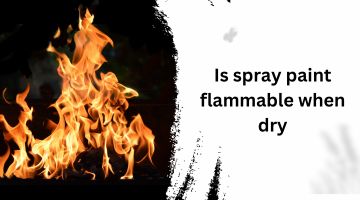Spray paint is a versatile and widely used tool for various painting projects, from arts and crafts to home improvement. However, with its widespread use comes the need to understand its safety aspects, particularly its flammability. One common question is: “Is spray paint flammable when dry?” To answer this, we must delve into the composition and behaviour of spray paint.
Importance of Understanding Spray Paint Safety
Understanding the flammability of spray paint, both when wet and dry, is crucial for ensuring safety during its use, storage, and disposal. This knowledge helps prevent accidents and ensures that users can enjoy the benefits of spray paint without unnecessary risks.
Understanding Spray Paint Composition
What is Spray Paint Made Of?
Spray paint is typically composed of pigments, binders, solvents, and propellants. The pigments provide color, the binders ensure the paint adheres to surfaces, the solvents keep the paint in a liquid state, and the propellants enable the paint to be sprayed from the can.
Role of Solvents in Spray Paint
Solvents are a key component in spray paint, as they dissolve the other ingredients and allow the paint to be sprayed smoothly. Common solvents include acetone, toluene, and xylene, all of which are highly flammable.
How Spray Paint Dries
When spray paint is applied, the solvents begin to evaporate, leaving behind the pigment and binder. This drying process involves a chemical change that transforms the paint from a liquid to a solid state.
Flammability of Wet Spray Paint
Why Wet Spray Paint is Flammable
Wet spray paint is highly flammable due to the presence of volatile organic compounds (VOCs) in the solvents. These VOCs can easily ignite if exposed to a flame or spark, posing a significant fire hazard.
Safety Precautions When Using Wet Spray Paint
To safely use wet spray paint, it is essential to:
- Work in a well-ventilated area.
- Keep away from open flames, sparks, and high heat.
- Use personal protective equipment, such as gloves and masks.
- Follow the manufacturer’s safety guidelines.
Read More: How to get spray paint off leather
Dry Spray Paint: Is It Still Flammable?
Chemical Changes During Drying
As spray paint dries, the solvents evaporate, and the remaining paint undergoes a chemical change. This transformation reduces the flammability of the paint, as most of the flammable components have dissipated.
Residual Solvents in Dry Spray Paint
Although the majority of solvents evaporate during drying, some residual solvents may remain trapped in the paint. These residual solvents can contribute to a slight flammability risk, particularly if the painted surface is exposed to extreme heat.
Safety Concerns with Dry Spray Paint
While dry spray paint is significantly less flammable than when wet, it is still important to exercise caution:
- Avoid exposing painted surfaces to high heat or open flames.
- Ensure proper curing time as recommended by the manufacturer.
- Be mindful of the environment in which the painted item is placed.
Testing Spray Paint Flammability
Methods to Test Flammability
Flammability testing of spray paint typically involves:
- Laboratory tests using controlled ignition sources.
- Real-world tests in simulated environments.
- Assessing the paint’s flash point (the lowest temperature at which it can vaporize to form an ignitable mixture in air).
Real-life Examples and Case Studies
Various studies and real-life incidents have demonstrated the flammability risks associated with both wet and dry spray paint. These examples highlight the importance of following safety guidelines to prevent accidents.
Environmental Factors Affecting Flammability
Impact of Temperature on Spray Paint
High temperatures can increase the flammability of spray paint by accelerating the evaporation of solvents and raising the likelihood of ignition. Conversely, low temperatures can slow the drying process and prolong the flammable state of the paint.
How Humidity Affects Flammability
High humidity levels can impact the drying process of spray paint, causing it to dry more slowly. This prolonged drying time can extend the period during which the paint is flammable. On the other hand, low humidity can speed up the drying process but may lead to uneven drying and other issues.
Safety Guidelines for Using Spray Paint
Proper Ventilation and Workspace Setup
Ensuring proper ventilation is crucial when using spray paint. This can be achieved by:
- Working outdoors or in a well-ventilated area.
- Using fans to circulate air.
- Wearing appropriate respiratory protection.
Personal Protective Equipment (PPE)
Using personal protective equipment (PPE) helps protect against the fumes and potential hazards associated with spray paint. Essential PPE includes:
- Gloves to protect the skin.
- Masks or respirators to filter out harmful fumes.
- Safety goggles to shield the eyes.
Alternatives to Traditional Spray Paint
Water-Based Spray Paints
Water-based spray paints are less flammable and contain fewer VOCs, making them a safer alternative. They are ideal for indoor use and offer similar performance to traditional spray paints.
Low-VOC Spray Paints
Low-VOC spray paints reduce the amount of harmful emissions released during use, making them a more environmentally friendly option. They are suitable for those concerned about air quality and safety.
Common Myths About Spray Paint Flammability
Debunking Myths and Misconceptions
Several myths surround the flammability of spray paint. For example:
- Myth: All spray paints are equally flammable when dry. Fact: The flammability of spray paint depends on its composition and the amount of residual solvents.
- Myth: Dry spray paint is completely safe from fire hazards. Fact: While less flammable, dry spray paint can still pose risks if not handled properly.
Clarifying Safety Guidelines
Clarifying and adhering to safety guidelines can prevent accidents. Always refer to the manufacturer’s instructions and industry standards for the safest use of spray paint.
Conclusion
Understanding the flammability of spray paint, both when wet and dry, is essential for safe use. While dry spray paint is less flammable, it is not entirely free from fire hazards. By following safety guidelines and using proper protective equipment, you can enjoy the benefits of spray paint while minimizing risks. Always prioritize safety and stay informed about the products you use.

